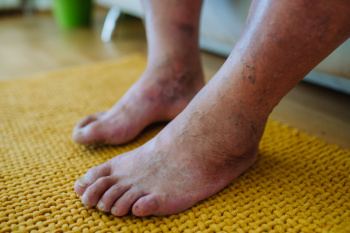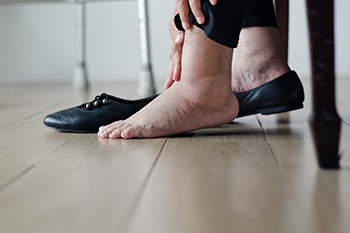Items filtered by date: September 2025
Causes and Symptoms of Onychomycosis

Onychomycosis is a fungal infection that affects the nails, causing them to become discolored, thickened, and brittle. The infection most commonly targets toenails but can also affect fingernails. It occurs when fungi, such as dermatophytes, yeasts, or molds, invade the nail bed and the surrounding tissue. The primary causes of toenail fungus include exposure to warm, damp environments, poor foot hygiene, and wearing tight-fitting shoes that do not allow the feet to breathe. Individuals with weakened immune systems, diabetes, or poor circulation are more prone to developing this condition. Common symptoms of onychomycosis include yellow or white streaks or spots on the nails, thickening of the nail, crumbling at the edges, and a foul odor. If left untreated, the infection can lead to further nail damage and spread to other nails or skin, making early detection and treatment essential. If you have any of the above symptoms, it is strongly suggested that you promptly contact a podiatrist who can effectively treat toenail fungus.
For more information about treatment, contact Gregory Kranzusch, DPM of Foot and Ankle Center of St. Charles County. Our doctors can provide the care you need to keep you pain-free and on your feet.
Toenail Fungus Treatment
Toenail fungus is a condition that affects many people and can be especially hard to get rid of. Fortunately, there are several methods to go about treating and avoiding it.
Antifungals & Deterrence
Oral antifungal medicine has been shown to be effective in many cases. It is important to consult with a podiatrist to determine the proper regiment for you, or potentially explore other options.
Applying foot powder on the feet and shoes helps keep the feet free of moisture and sweat.
Sandals or open toed shoes – Wearing these will allow air movement and help keep feet dry. They also expose your feet to light, which fungus cannot tolerate. Socks with moisture wicking material also help as well.
If you have any questions please contact our office located in St. Charles, MO . We offer the newest diagnostic and treatment technologies for all your foot and ankle needs.
Important Things to Know About Gout in the Feet

Gout is a form of arthritis that often affects the joints in the feet, especially the big toe. It occurs when uric acid builds up in the blood and forms sharp crystals in the joints. This can cause sudden and severe pain, redness, and swelling that may last for several days. Gout flare-ups are often triggered by foods high in purines, such as red meat, shellfish, or alcohol. Dehydration, obesity, and certain medications may also increase the risk. Managing gout involves lifestyle changes like staying hydrated, maintaining a balanced diet, and limiting alcohol. Medications are sometimes needed to control uric acid levels and reduce inflammation. Ignoring gout can lead to lasting joint damage and decreased mobility. If you experience painful flare ups in your feet, it is suggested that you meet with a podiatrist for a proper diagnosis and appropriate treatment.
Gout is a foot condition that requires certain treatment and care. If you are seeking treatment, contact Gregory Kranzusch, DPM from Foot and Ankle Center of St. Charles County. Our doctors will treat your foot and ankle needs.
What Is Gout?
Gout is a type of arthritis caused by a buildup of uric acid in the bloodstream. It often develops in the foot, especially the big toe area, although it can manifest in other parts of the body as well. Gout can make walking and standing very painful and is especially common in diabetics and the obese.
People typically get gout because of a poor diet. Genetic predisposition is also a factor. The children of parents who have had gout frequently have a chance of developing it themselves.
Gout can easily be identified by redness and inflammation of the big toe and the surrounding areas of the foot. Other symptoms include extreme fatigue, joint pain, and running high fevers. Sometimes corticosteroid drugs can be prescribed to treat gout, but the best way to combat this disease is to get more exercise and eat a better diet.
If you have any questions, please feel free to contact our office located in St. Charles, MO . We offer the newest diagnostic and treatment technologies for all your foot care needs.
Protecting Your Feet From Serious Diabetic Complications

Foot problems are a serious concern for diabetic patients, often caused by poor circulation and nerve damage, known as peripheral neuropathy. Symptoms may include tingling, burning sensations, slow-healing wounds, or unnoticed injuries due to reduced feeling in the feet. Visually, the skin may appear dry, cracked, or discolored, and ulcers or infections may develop without pain. These changes can lead to severe complications, if not properly managed. A podiatrist plays a critical role in diabetic foot care by regularly monitoring foot health, checking for signs of nerve damage, infection, or poor circulation. Treatment may include wound care, toenail care, pressure relief techniques, and guidance on proper footwear. Preventive care is essential to avoid ulcers, infections, and even loss of limb. A podiatrist also provides education on daily foot inspection and hygiene. If you have diabetes, it is suggested that you schedule an appointment with a podiatrist to ensure early detection and personalized care for diabetic foot health.
Diabetic foot care is important in preventing foot ailments such as ulcers. If you are suffering from diabetes or have any other concerns about your feet, contact Gregory Kranzusch, DPM from Foot and Ankle Center of St. Charles County. Our doctors can provide the care you need to keep you pain-free and on your feet.
Diabetic Foot Care
Diabetes affects millions of people every year. The condition can damage blood vessels in many parts of the body, especially the feet. Because of this, taking care of your feet is essential if you have diabetes, and having a podiatrist help monitor your foot health is highly recommended.
The Importance of Caring for Your Feet
- Routinely inspect your feet for bruises or sores.
- Wear socks that fit your feet comfortably.
- Wear comfortable shoes that provide adequate support.
Patients with diabetes should have their doctor monitor their blood levels, as blood sugar levels play such a huge role in diabetic care. Monitoring these levels on a regular basis is highly advised.
It is always best to inform your healthcare professional of any concerns you may have regarding your feet, especially for diabetic patients. Early treatment and routine foot examinations are keys to maintaining proper health, especially because severe complications can arise if proper treatment is not applied.
If you have any questions, please feel free to contact our office located in St. Charles, MO . We offer the newest diagnostic and treatment technologies for all your foot care needs.
See Your Foot Specialist Regularly If You Work On Your Feet
Common Foot Problems in Seniors

As people age, the feet undergo natural changes that can lead to discomfort and mobility issues. Seniors often experience fat pad atrophy, which reduces cushioning in the heels and balls of the feet, leading to pain. Cracked heels can develop from dry skin, while bunions and ingrown toenails may cause swelling, redness, and difficulty walking. Morton's neuroma can create sharp pain or tingling between the toes. These conditions can impact daily activities and overall quality of life. A podiatrist can provide expert evaluation, offer treatments such as orthotics, padding, or corrective procedures, and recommend preventive care. If you or a loved one are experiencing foot problems, it is suggested that you consult a podiatrist who can provide an accurate diagnosis, and offer effective treatment solutions.
Proper foot care is something many older adults forget to consider. If you have any concerns about your feet and ankles, contact Gregory Kranzusch, DPM from Foot and Ankle Center of St. Charles County. Our doctors can provide the care you need to keep you pain-free and on your feet.
The Elderly and Their Feet
As we age we start to notice many changes in our body, but the elder population may not notice them right away. Medical conditions may prevent the elderly to take notice of their foot health right away. Poor vision is a lead contributor to not taking action for the elderly.
Common Conditions
- Neuropathy – can reduce feeling in the feet and can hide many life-threatening medical conditions.
- Reduced flexibility – prevents the ability of proper toenail trimming, and foot cleaning. If left untreated, it may lead to further medical issues.
- Foot sores – amongst the older population can be serious before they are discovered. Some of the problematic conditions they may face are:
- Gouging toenails affecting nearby toe
- Shoes that don’t fit properly
- Pressure sores
- Loss of circulation in legs & feet
- Edema & swelling of feet and ankles
Susceptible Infections
Diabetes and poor circulation can cause general loss of sensitivity over the years, turning a simple cut into a serious issue.
If you have any questions, please feel free to contact our office located in St. Charles, MO . We offer the newest diagnostic and treatment technologies for all your foot care needs.
Important Facts About Broken Toes

A broken toe is a common injury that occurs when one of the small bones in the foot is fractured due to trauma or excessive force. Causes often include stubbing the toe, dropping a heavy object on the foot, or sports related accidents. Symptoms may involve pain, swelling, bruising, difficulty walking, or visible deformity. Risk factors include participating in high impact activities, wearing improper footwear, osteoporosis, or previous foot injuries. A podiatrist can help by diagnosing the fracture with imaging, providing proper treatment, and guiding recovery to ensure correct healing. If you think you may have broken your toe, do not ignore the pain. It is strongly suggested that you promptly contact a podiatrist who can accurately diagnose and treat this painful condition.
Broken toes may cause a lot of pain and should be treated as soon as possible. If you have any concerns about your feet, contact Gregory Kranzusch, DPM from Foot and Ankle Center of St. Charles County. Our doctors will treat your foot and ankle needs.
What Is a Broken Toe?
A broken toe occurs when one or more of the toe bones of the foot are broken after an injury. Injuries such as stubbing your toe or dropping a heavy object on it may cause a toe fracture.
Symptoms of a Broken Toe
- Swelling
- Pain (with/without wearing shoes)
- Stiffness
- Nail Injury
Although the injured toe should be monitored daily, it is especially important to have a podiatrist look at your toe if you have severe symptoms. Some of these symptoms include worsening or new pain that is not relieved with medication, sores, redness, or open wounds near the toe.
If you have any questions please feel free to contact our office located in St. Charles, MO . We offer the newest diagnostic tools and technology to treat your foot and ankle needs.

